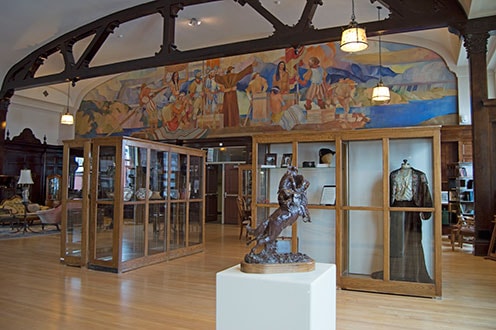Adams State Founder & Former CO Governor William H. “Billy” Adams
Adams Family Tree
Newspapers 1885 to 1889
Biography of William H. Adams
By James O. Chipman
Colorado State Staff Archivist
William H. Adams was born at Blue Mounds, Wisconsin, on February 15, 1861. His father was a native of Kentucky, his mother of New York, and both were pioneers of the lead mining districts of Wisconsin. In 1871 the family crossed the plains by wagon, stopped a short time at Greeley, again at Denver, and located for some time at Colorado Springs. Here William continued a common school education begun in Wisconsin. His parents came west for the sake of their son, George, who was struggling with tuberculosis. George improved for a time, but then died in 1873. While Billy’s folks went back to Wisconsin, he and his brother, Alva, stayed in Colorado.
Alva and Billy moved to Pueblo where Alva established a hardware store. Billy Adams managed his brother’s hardware store for a short time but decided he didn’t like being confined indoors as he always liked to work with cattle and loved horses. He moved to Alamosa in 1878 and tried almost as many jobs as he had fingers on his hands working as a teamster, a cowpuncher, a hay hand and an irrigator. Little, by little, he picked up land and bought a few cattle so that in a few years he had a working ranch.
He had few years of formal schooling, but while working on the various ranches, he found he had plenty of spare time, especially at night while he was sitting at a campfire or in a saddle. It was during these periods that he read, whenever he found a scrap of time. He studied law, history, government and economics, picking up an interest in politics along the way. Almost before he was old enough to vote, he was first elected City Treasurer, then mayor of Alamosa, and finally Conejos County Commissioner in 1883. Three years later in 1886, he was elected to the State Legislature as a representative and two years after that to the State Senate, where he served continuously until he was elected governor thirty-eight years later in 1926.
In 1883, he was one of the organizers of the San Luis Canal near Alamosa. He continued to expand his ranch into a large area of land along the Rio Grande River and the La Jara meadows in the mountains to the west. When Adams first arrived in the area, the range was being worked from Saguache to the New Mexico line and from Del Norte to Fort Garland. He saw the San Luis Valley change from this vast cattle range to its present development as one of Colorado’s great agricultural districts.
During his long career in the legislature, there were times when Adams was the only Democrat in the senate while there were other times when he led the majority party. Good weather or bad, he fought for what he thought was best for his county and his state. In the forty-two years he served in the legislative halls, he introduced only one bill. The bill was passed and created the Alamosa State Normal School at Alamosa. Later it was changed to the Adams State Teachers College. He was also instrumental in creating the Colorado Agricultural College at Fort Collins, the Colorado State Teachers College at Greeley, and Western State College at Gunnison.
As governor, he held a tight line on state expenses. “I tried to do for the people of Colorado just what I’d do for my own business,” he said once, “cut corners and watch expenses.” His administration is remembered for his efforts in obtaining both economy and efficiency in state government. He supported appropriations for two year periods only. He lobbied to have the heads of departments and administrative boards removed from civil service and put under the governor’s direction.
In the field of corrections, Governor Adams granted no pardons and rarely reduced sentences; and he never intervened when a death penalty was handed down. A prison riot at Canon City in October of 1929, cost the lives of eight guards and five prisoners, and focused attention upon overcrowding, idleness and other unfortunate conditions existing in the state penitentiary. A fire at the same institution in the following February further emphasized the need for prison reform measures. Adams appointed and supported Roy Best as warden of the state penitentiary, and it was Billy who stuck by Best when he was charged by the federal government in 1952 with torturing convicts and when he was suspended for two years by the State Civil Service Commission.
Another major challenge with which Adams had to deal was a strike of coal miners in 1927. In this conflict, the Industrial Workers of the World took a prominent part. A clash in Boulder County between strikers and state militia resulted in the deaths of eight strikers and the wounding of twenty others. Adams’ response to this strike and his stands on many other issues made him very popular with the voters. He was elected twice as governor during Republican landslides, once as the only Democrat elected to a state office!
Just as he didn’t appreciate “silver-tongued” oratory, Billy didn’t like fancy clothes. He was small in stature and at all times featured the same kind of clothes. A Stetson hat of the cowboy type, but not of the five gallon variety, was his head-piece. Often it was battered and worn, along with his cowboy boots, while he was riding the range among his cattle. He always wore a dark grey, plain patterned suit with the same cut and material. The only exception was when Charles A. Lindbergh came to town, when he bought a blue suit for the occasion.
Adams was married twice. His first marriage, to Emma Ottaway, the granddaughter of Colonel John M. Chivington, ended in divorce. His second wife, Hattie Mullins, died in 1918, two years after their marriage. No children were born to either marriage. Right after his second marriage, he bought and gave to his wife a shiny, new model T Ford. He never learned to drive himself, but enjoyed long evening rides with his wife at the wheel.
William H. Adams died on February 3, 1954, in Alamosa at the age of ninety-two and is buried in that city. He will be remembered for his fifty years of public service. Adams State College in Alamosa is an enduring monument to his interest in education and his devotion to the district he served for so many years. It was to Colorado’s great benefit that the Adams’ family decided to move out west in 1871 as the state became the recipient of two brothers, Alva and William who both became governors, and one nephew, Alva B.Adams who served in the United States Senate.



